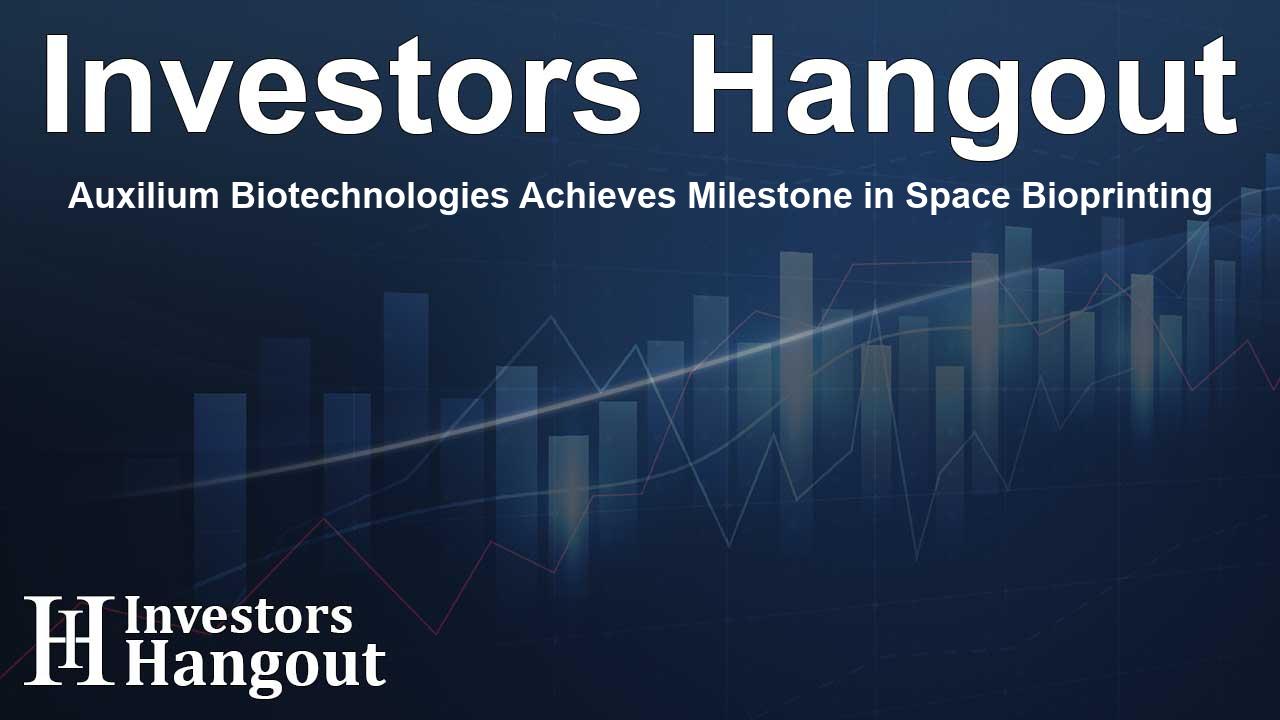Auxilium Biotechnologies Achieves Milestone in Space Bioprinting

Auxilium Biotechnologies Achieves Milestone in Space Bioprinting
Auxilium Biotechnologies, a vanguard in regenerative medicine and bioprinting innovation, has marked a historic moment by successfully deploying its advanced 3D bioprinter aboard the International Space Station (ISS). This pioneering platform has achieved the extraordinary feat of printing eight implantable medical devices concurrently within the span of just two hours.
Leveraging Microgravity for Advanced Solutions
The Auxilium Microfabrication Platform (AMP-1) capitalizes on the distinctive properties of microgravity to create medical devices with unparalleled precision and efficiency. The microgravity environment offers significant advantages for bioprinting, including more consistent material distribution and the capacity to construct finer and more intricate structures that would otherwise falter under Earth's gravitational pull. Such advantages are crucial for developing implants that incorporate biological materials or therapeutic agents, ensuring the reliability that ground-based manufacturing cannot always provide.
Seamless Printing Process in Space
This bioprinting system, which remains stationed on the ISS, utilizes lightweight cartridges preloaded with necessary biological materials. Implants created through this process are subsequently returned to Earth. Remarkably, each print session consumes less than a minute of astronaut time, drastically reducing labor costs that can reach up to $130,000 per hour. Furthermore, the lightweight nature of these cartridges promotes a more economical and sustainable transportation process using commercial resupply missions.
An Historic Achievement
“The deployment of our bioprinter on the ISS is a landmark achievement for space biomanufacturing and Auxilium,” proclaimed Jacob Koffler, PhD MBA, the CEO of Auxilium. “AMP-1 represents the most advanced 3D-printing platform ever sent to space, empowering us to engineer regenerative medicine treatments that have the potential to revolutionize patient care. This advancement not only confirms the viability of mass 3D-printing production in space but also underscores the economic possibilities for space-based manufacturing. Our bioprinting endeavors in microgravity are bound to spur innovation that will benefit life on Earth, in commercial space stations orbiting Earth, as well as in future space exploration, including imminent Moon missions.”
Streamlined Integration and Future Development
Auxilium's Director of Engineering, Isac Lazarovits, expressed enthusiasm regarding this technological leap, stating, “The integration of the printer on the ISS needed only two minutes of astronaut time for complete operation — an impressive milestone in itself. For the first time ever, we have realized a straightforward integration solution for a manufacturing facility in space. With AMP-1 now functional, we are rapidly advancing our biomanufacturing research and the creation of regenerative medical devices.” He conveyed appreciation to their collaborators at Space Tango and Invetech, who played essential roles in bringing this project to fruition.
Future Applications of Bioprinting Technology
Currently, AMP-1's early applications emphasize the production of implants for peripheral nerve repair. Looking ahead, future milestones will include preclinical animal testing and eventual commercialization. In the near future, these implants will be deployed on Earth, while extended applications aim to facilitate human health for space exploration, such as missions to the Moon, Mars, and beyond. The capacity to bioprint implants while in space could profoundly enhance medical care for crews on prolonged missions.
Continued Legacy of Innovation
Auxilium’s pioneering efforts in microgravity bioprinting draw inspiration from NASA’s legacy of medical innovations, which have fostered developments like the Left Ventricular Assist Device (LVAD), enhanced imaging technologies for MRIs and CT scans, among other life-altering medical instruments. The AMP-1 could potentially transform healthcare practices both on Earth and in extraterrestrial environments, marking a significant step in realizing the role of space-based manufacturing in evolving medical solutions.
Final Thoughts on Bioprinting in Space
These groundbreaking bioprinting capabilities symbolize the future of manufacturing in space. With financial backing from NASA’s InSpace Production Applications (InSpa) program, Auxilium has stepped forward as a frontrunner in this domain, maintaining a robust market position and attracting notable investor interest. The success of Auxilium highlights the essential position of small businesses in forging the path for more comprehensive space exploration and commercialization.
About Auxilium Biotechnologies
Auxilium Biotechnologies is a pioneering biotechnology company dedicated to developing innovative solutions aimed at treating traumatic injuries to the nervous system. Fostering a spirit of innovation and collaboration, the company strives to create advanced bioprinting technologies and implantable medical devices that seek to enhance lives globally.
Frequently Asked Questions
What is the significance of Auxilium's bioprinter on the ISS?
Auxilium's bioprinter marks a breakthrough in space biomanufacturing, enabling the simultaneous production of medical implants in microgravity, which could revolutionize medical care.
How does microgravity benefit bioprinting?
Microgravity allows for more precise material distribution and the creation of intricate structures that would collapse under Earth's gravity, leading to better quality medical devices.
What are the future applications of the AMP-1 bioprinter?
The AMP-1 is expected to produce implants for peripheral nerve repair, with plans for further testing and commercial use, aiming to support future space exploration missions.
Who collaborated with Auxilium for this project?
Auxilium partnered with Space Tango and Invetech in the development and deployment of their bioprinter on the ISS, contributing to the success of this innovative project.
How does Auxilium intend to use the funds from NASA?
Funding from NASA’s InSpace Production Applications will help Auxilium to solidify its position in space biomanufacturing and explore new avenues for medical innovations.
About The Author
Contact Riley Hayes privately here. Or send an email with ATTN: Riley Hayes as the subject to contact@investorshangout.com.
About Investors Hangout
Investors Hangout is a leading online stock forum for financial discussion and learning, offering a wide range of free tools and resources. It draws in traders of all levels, who exchange market knowledge, investigate trading tactics, and keep an eye on industry developments in real time. Featuring financial articles, stock message boards, quotes, charts, company profiles, and live news updates. Through cooperative learning and a wealth of informational resources, it helps users from novices creating their first portfolios to experts honing their techniques. Join Investors Hangout today: https://investorshangout.com/
The content of this article is based on factual, publicly available information and does not represent legal, financial, or investment advice. Investors Hangout does not offer financial advice, and the author is not a licensed financial advisor. Consult a qualified advisor before making any financial or investment decisions based on this article. This article should not be considered advice to purchase, sell, or hold any securities or other investments. If any of the material provided here is inaccurate, please contact us for corrections.
